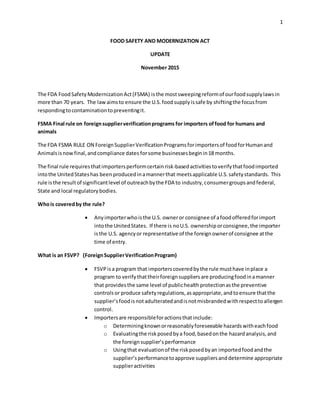
FOOD SAFETY AND MODERNIZATION ACTsec 2
- 1. 1 FOOD SAFETY AND MODERNIZATION ACT UPDATE November 2015 The FDA FoodSafetyModernizationAct(FSMA) isthe mostsweepingreformof ourfoodsupplylawsin more than 70 years. The lawaimsto ensure the U.S.foodsupplyissafe by shiftingthe focusfrom respondingtocontaminationtopreventingit. FSMA Final rule on foreignsupplierverificationprograms for importers offood for humans and animals The FDA FSMA RULE ON ForeignSupplierVerificationProgramsforimportersof foodforHumanand Animalsisnowfinal,andcompliance dates forsome businessesbeginin18 months. The final rule requiresthatimportersperformcertainrisk-basedactivitiestoverifythatfoodimported intothe UnitedStateshas been producedinamannerthat meetsapplicable U.S.safetystandards. This rule isthe resultof significantlevel of outreachbythe FDA to industry,consumergroupsandfederal, State and local regulatorybodies. Whois coveredby the rule? Anyimporterwhoisthe U.S. owneror consignee of afoodofferedforimport intothe UnitedStates. If there is noU.S. ownershiporconsignee,the importer isthe U.S. agencyor representative of the foreignownerof consignee atthe time of entry. What is an FSVP? (ForeignSupplierVerificationProgram) FSVP isa program that importerscoveredbythe rule musthave inplace a program to verifythattheirforeignsuppliersare producingfoodinamanner that providesthe same level of publichealthprotectionasthe preventive controlsor produce safetyregulations,asappropriate,andtoensure thatthe supplier’sfoodisnotadulteratedandisnotmisbrandedwithrespecttoallergen control. Importersare responsibleforactionsthatinclude: o Determiningknownorreasonablyforeseeable hazardswitheachfood o Evaluatingthe riskposedbya food,basedonthe hazardanalysis,and the foreignsupplier’sperformance o Usingthat evaluationof the riskposedbyan importedfoodandthe supplier’sperformancetoapprove suppliersanddetermine appropriate supplieractivities
- 2. 2 o Conductingsupplierverificationactivities o Conductingcorrective actions Importersmustestablishandfollowwrittenprocedurestoensure thattheyimportfoodsonlyfrom foreignsuppliersapprovedbasedonanevaluationof the riskposedbythe importedfoodandthe supplier’sperformanceor,whennecessaryona temporary basis,fromunapprovedsupplierswhose foodsare subjectedtoadequate verificationactivitiesbefore beingimported. Importersare requiredtodevelop,maintainandfollow anFSVPforeachfoodbroughtintothe United Statesand the foreignsupplierof thatfood. Importersare not requiredtoevaluate the foodandsupplierorconductsupplierverificationactivitiesif theyreceive adequateassurancesthatasubsequententityinthe distributionchain,suchasthe importer’scustomer,isprocessingthe foodforfoodsafetyinaccordance withapplicable requirements. Importersmustalsodisclose indocumentsaccompanyingthe foodthatthe foodisnot processedto control the hazard. Hazard Analysis: An importerisrequiredtoidentifyandevaluate the knownorreasonablyforeseeablehazardsforeach type of foodit importsto determineif there are anyhazardsrequiringacontrol. Thisis done basedon experience, illnessdata,scientificreportsandotherinformation. The hazardsinclude: Biological Hazards,including parasites anddisease causingbacteria Chemical Hazards,includingradiological hazards,pesticide anddrugresidues,natural toxins,fooddecomposition,unapprovedfoodorcoloradditives,andfoodallergens Physical hazards,suchas glassand metals Foodcouldhave hazards reasonablylikelyto cause illnessorinjurythatoccurnaturally,andare unintentionallyintroduced. They couldbe hazardsthat are intentionallyintroducedforpurposesof economicgain,suchas substitutingalesscostlyingredient. The analysismust assess the probability that these hazards will occur in the absence of controlsand the severityofthe illnessorinjury that couldoccur. The evaluationwouldhave toconsiderfactorsthatinclude the following: Formulationof the food Conditionanddesignof the facilityandequipmentthatproducesthe food Raw Materialsandotheringredients Transportationpractices Harvestingtoraisingto manufacturingtoprocessingtopackaging Storage and distribution Sanitation,includingemployeehygiene
- 3. 3 Evaluation Food Safetyand SupplierPerformance The Hazard Analysis Applicable FDA foodsafetyregulations,andinformationregardingthe foreign supplier’scompliance The foreignsupplier’sfoodsafetyhistory Otherfactors includingstorage andtransportationpractices The importercan relyon anotherentitytoperformthe riskfactorsso longas the importerreviews and assessesthe relevantdocumentation. SupplierVerification: Basedon the evaluationof riskconducted,the importermustestablishandfollow writtenproceduresto ensure thatit onlyimportsfromapprovedforeignsuppliersandmustconduct appropriate supplier verificationactivities. Several methodscouldaccomplishthisgoal theyinclude: Annual onsite auditsof the suppliers facility Samplingandtestingof product A reviewof the suppliersrelevantfoodsafetyrecords An importercanrelyon anotherentitytodetermineandperformappropriate supplierverification activities. Corrective Actions: If somethingisdiscoveredthatrequire corrective actionsthe importermusttake control andcorrectthe foodsafetyissue. Thismustbe documented,testedforeffectivenessand evidence thatthe controlsput inplace to preventa reoccurrence. If ithas beendeterminedthatthe supplierhasnotusedprocessand proceduresthatprovide proof thatthe fooditemsare safe for consumption oradulteratedinanywayor misbrandedwithrespecttoallergenlabelingthe product cannotbe made available fordistributionin the UnitedStates. Please note the FSVPdoesnotcoverthe fooditemslistedunderREGULATED HACCP and the following: Juice,fishandfisheryproductsincompliance withthe FDA’sHazardAnalysisandCritical Control Point(HACCP) Certainmeat, poultryandeggproductsregulatedbythe U.S. Departmentof Agriculture at the time of importation Foodthat is importedforprocessingandfuture export Compliance Dates The date bywhichimportersmustcomplywiththe FSVPregulationsisthe latestof the followingdates:
- 4. 4 18 monthsafterpublicationof the final rule For the importationof foodfroma supplierthatissubjecttothe preventative controlsor produce safetyrules,six monthsafterthe foreignsupplierisrequiredtomeetthe relevant regulations For an importerthatis itself amanufacturerorprocessorsubjecttothe supply-chainprogram provisionsinthe preventive controlsregulations,the date bywhichithasto complywiththose provisions. A range of compliance dateswere establishedinthe preventivecontrolsrulesfor the supply-chainprogramprovisions,whichvarybasedonthe size of the receivingfacilityand whenthe receivingfacility’ssupplierisrequiredtocomplywiththe new FSMA regulations. The recommendationisto start this verificationprocessnow, reviewall inbounditemsto determine the originof that product and followthe guidelinessetforthlistedabove. In addition you needto include all domestic suppliersinyour food safetyprograms. Requesta” LETTER OF COMPLIANCE” from all your suppliers. This letterof compliance shouldinclude the following: Confirmationof writtenfood safetyprograms Sanitation controls Employee GMPtraining and personal hygiene practices Temperature control methods HACCP plans inplace History of regulatory inspectionsincludingFDAand USDA include any 439 forms and corrective actions. Resultsof any “Third Party Audits” such as AIB Update these letterson compliance annually and have them available for audits and inspections The Food Safetyrulesand laws are here to stay. From farm to the dinner table all are now involved and will be heldresponsible toprovide a safe wholesome foodproduct. Please contactme if you have anyquestionsorconcerns Regards Howard Schwenzer PresidentSchwenzerSafetyServices Health& SafetyConsulting AIBFood Defense Coordinator OSHA OutreachTrainer
